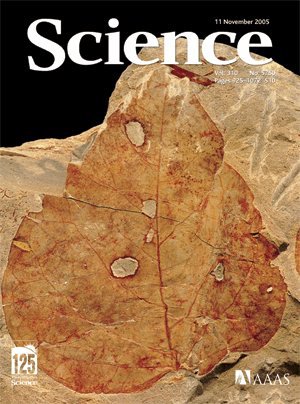From the University of Florida press release:
The beginning of the Eocene was characterized by rapid global warming after a huge release of carbon into the atmosphere and ocean. Plant fossils described document rapid, continental-scale changes in the geographic ranges of plants coincident with the warming.The findings provide the first evidence that land plants changed drastically during a period of sudden global warming 55 million years ago, said Jonathan Bloch, a University of Florida vertebrate paleontologist and member of the research team.
"It indicates that should we have a period of rapid global warming on that scale today, we might expect very dramatic changes to the biota of the planet, not just the mammals and other vertebrates, but forests also completely changing," said Bloch.
 Scientists have known there was significant turnover in mammals during this rapid period of global warming called the Paleocene-Eocene Thermal Maximum, in which temperatures rose by perhaps as much as 10 degrees in the relatively short time span of 10,000 years, then lasting for another 80,000 to 100,000 years, Bloch said. Global warming allowed mammals to emigrate across northern land bridges, marking the first appearance of perissodactlys in the form of the earliest known horse; artiodactyls, a group of even-toed ungulates that includes pigs, camels and hippos; as well as modern primates, he said.
Scientists have known there was significant turnover in mammals during this rapid period of global warming called the Paleocene-Eocene Thermal Maximum, in which temperatures rose by perhaps as much as 10 degrees in the relatively short time span of 10,000 years, then lasting for another 80,000 to 100,000 years, Bloch said. Global warming allowed mammals to emigrate across northern land bridges, marking the first appearance of perissodactlys in the form of the earliest known horse; artiodactyls, a group of even-toed ungulates that includes pigs, camels and hippos; as well as modern primates, he said. But until now, no clues were available as to what happened to plants during this shift, considered one of the most extreme global warming events during the Cenozoic, the "Age of Mammals," Bloch said. "It was very puzzling because it looked like there was nothing going on with plants, which was rather strange and disconcerting."
Excavations by team leader Scott Wing, in the Bighorn Basin of northwestern Wyoming uncovered fossil leaves and pollen alongside fossilized mammals in rocks that were deposited during this turbulent geologic interval.
"Up until this point we have not had a place in which we have mammal and plant remains preserved in the same rocks spanning what we call the Paleocene-Eocene boundary," Bloch said. "Amazingly, these plants came from what would have been more tropical environments."
Photo by S. Wing